推薦產品
品質等級
化驗
≥98% (HPLC)
形狀
solid
製造商/商標名
Calbiochem®
儲存條件
OK to freeze
protect from light
顏色
yellow
溶解度
methanol: 1.5 mg/mL
100% DMSO: 100 mg/mL
90% DMSO: 75 mg/mL
運輸包裝
wet ice
儲存溫度
−20°C
InChI
1S/C18H16N2O2/c1-12-7-8-15-14(11-12)16(21)18(22)9-10-20(17(18)19-15)13-5-3-2-4-6-13/h2-8,11,22H,9-10H2,1H3/t18-/m0/s1
InChI 密鑰
LZAXPYOBKSJSEX-SFHVURJKSA-N
一般說明
The inactive enantiomer of (±)-Blebbistatin (Cat. No. 203390). Useful as a negative control for the active enantiomer (Cat. No. 203391).
The inactive enantiomer of (±)-Blebbistatin (Cat. No. 203390). Also useful as a negative control for the more active enantiomer (-)-Blebbistatin (Cat. No. 203391).
生化/生理作用
Cell permeable: no
Primary Target
Inactive enantiomer of (±)-Blebbistatin
Inactive enantiomer of (±)-Blebbistatin
Product does not compete with ATP.
Reversible: no
包裝
Packaged under inert gas
警告
Toxicity: Harmful & Carcinogenic / Teratogenic (E)
重構
Following reconstitution in methanol, aliquot and freeze (-20°C). Stock solutions in 90% DMSO or methanol are stable for up to 1 month at -20°C. Stock solutions in 100% DMSO are unstable; reconstitute just prior to use.
其他說明
Shu, S., et al. 2005. Proc. Natl. Acad. Sci. USA102, 1472.
Jacobelli, J., et al. 2004. Nat. Immunol.5, 531.
Kovacs, M., et al. 2004. J. Biol. Chem.279, 35557.
Straight, A.F., et al. 2003. Science299, 1743.
Jacobelli, J., et al. 2004. Nat. Immunol.5, 531.
Kovacs, M., et al. 2004. J. Biol. Chem.279, 35557.
Straight, A.F., et al. 2003. Science299, 1743.
法律資訊
CALBIOCHEM is a registered trademark of Merck KGaA, Darmstadt, Germany
儲存類別代碼
11 - Combustible Solids
水污染物質分類(WGK)
WGK 1
閃點(°F)
Not applicable
閃點(°C)
Not applicable
分析證明 (COA)
輸入產品批次/批號來搜索 分析證明 (COA)。在產品’s標籤上找到批次和批號,寫有 ‘Lot’或‘Batch’.。
Ying Liu et al.
Kidney diseases (Basel, Switzerland), 6(6), 422-433 (2020-12-15)
Levels of urinary microvesicles, which are increased during various kidney injuries, have diagnostic potential for renal diseases. However, the significance of urinary microvesicles as a renal disease indicator is dampened by the difficulty to ascertain their cell source. The aim
我們的科學家團隊在所有研究領域都有豐富的經驗,包括生命科學、材料科學、化學合成、色譜、分析等.
聯絡技術服務








